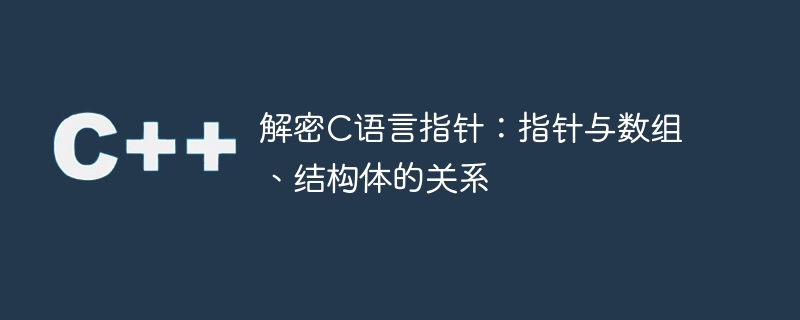

Decrypting C language pointers: the relationship between pointers and arrays and structures requires specific code examples
Introduction:
The pointer in C language is a powerful And flexible features, it allows programmers to directly manipulate computer memory addresses. The understanding of pointers is crucial to an in-depth mastery of the C language. This article will focus on the relationship between pointers, arrays, and structures, and explain their use through specific code examples.
The example is as follows:
#include <stdio.h>
int main() {
int nums[] = {1, 2, 3, 4, 5};
int *ptr = nums; // 将数组名nums赋值给指针ptr
printf("数组第一个元素:%d
", *ptr); // 输出1,使用指针访问数组第一个元素
ptr++; // 指针自增1,指向数组第二个元素
printf("数组第二个元素:%d
", *ptr); // 输出2,使用指针访问数组第二个元素
return 0;
}In the above code, int *ptr = nums;Assign the array name nums to the pointer ptr, so that array elements can be accessed through pointers. *ptr represents the content in the memory address pointed by the pointer, that is, the element in the array.
The example is as follows:
#include <stdio.h>
struct Student {
char name[20];
int age;
};
int main() {
struct Student stu1 = {"Alice", 18};
struct Student *ptr = &stu1; // 将结构体stu1的地址赋值给指针ptr
printf("姓名:%s
", ptr->name); // 输出stu1结构体的name成员
printf("年龄:%d
", ptr->age); // 输出stu1结构体的age成员
return 0;
}In the above code, struct Student *ptr = &stu1;Assign the address of the structure stu1 Give the pointer ptr so that you can access the structure members through the pointer. ptr->name represents the name member in the structure pointed to by the pointer, ptr->age represents the # member in the structure pointed to by the pointer. ##age members.
Pointers play a vital role in the C language. Its relationship with arrays and structures allows us to operate memory more flexibly. Through the specific code examples in this article, we have a deeper understanding of the relationship between pointers, arrays, and structures. I hope that by studying this article, readers can become more proficient in using pointers to solve practical problems and improve programming efficiency.
The above is the detailed content of Revealing the secrets of C language pointers: the connection between pointers, arrays and structures. For more information, please follow other related articles on the PHP Chinese website!
 What are the definitions of arrays?
What are the definitions of arrays?
 js string to array
js string to array
 Array initialization method
Array initialization method
 c array initialization method
c array initialization method
 How to find the maximum and minimum value of array elements in Java
How to find the maximum and minimum value of array elements in Java
 How to remove the first few elements of an array in php
How to remove the first few elements of an array in php
 Summary of java basic knowledge
Summary of java basic knowledge
 Zero-based Java self-study tutorial
Zero-based Java self-study tutorial




